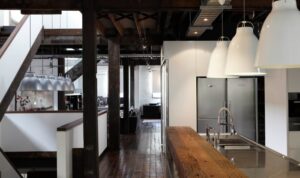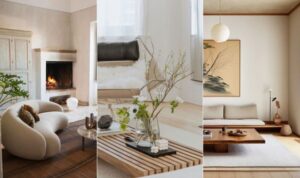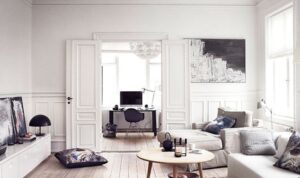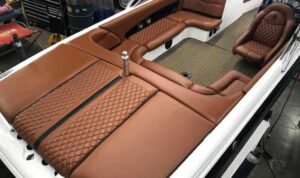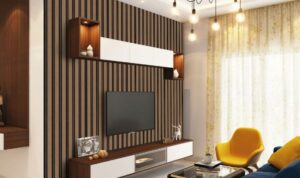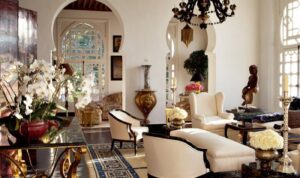Embark on a journey through the world of industrial interior design, where raw materials and sleek aesthetics collide to create a unique style that is both rugged and refined.
Delve deeper into the key elements that define industrial interior design and discover how it stands out from other design styles.
Definition of Industrial Interior
Industrial interior design is a style that draws inspiration from old factories and industrial spaces. It focuses on showcasing raw materials, structural elements, and functional design. This design aesthetic is characterized by a blend of rustic and modern elements, creating a unique and edgy look.
Key Characteristics of Industrial Interior Design
Industrial interior design is known for its distinct features that set it apart from other styles. Some key characteristics include:
- Exposed brick walls and concrete floors
- Metal accents such as steel beams, pipes, and light fixtures
- Utilitarian furniture with a focus on functionality
- Weathered or distressed wood elements
- Neutral color palette with pops of industrial colors like black, grey, and metallics
Elements Found in Industrial Interior Design
Elements commonly found in industrial interior design help create a cohesive and industrial-inspired space. Some examples include:
- Edison bulb light fixtures
- Vintage or salvaged furniture pieces
- Exposed ductwork and piping
- Industrial-style shelving units
- Raw and unfinished textures
Comparison to Other Interior Design Styles
Industrial interior design stands out from other styles due to its rugged and unfinished look. While minimalism focuses on simplicity and clean lines, industrial design embraces the raw and imperfect aesthetic. Additionally, industrial design differs from traditional styles like French country or Victorian, which prioritize ornate details and luxurious finishes.
Color Palette and Materials
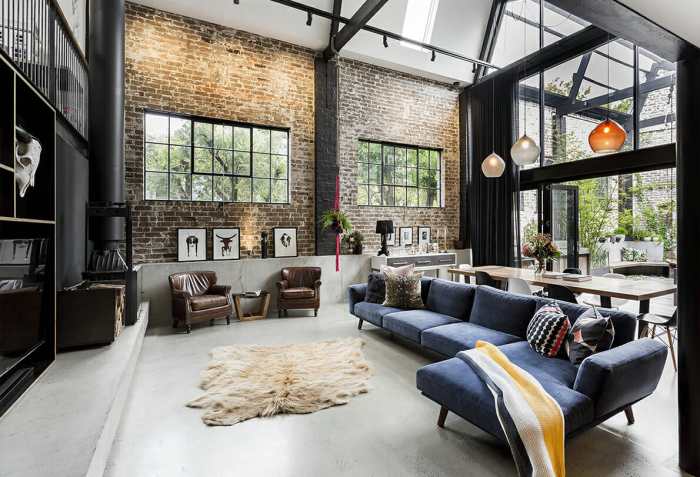
Industrial interior design typically features a color palette that revolves around neutral tones such as grey, black, white, and brown. These colors help create a sense of rawness and simplicity that is characteristic of industrial spaces.
Materials Used in Industrial Interior Design
In industrial interior design, materials play a crucial role in achieving the desired aesthetic. Commonly used materials include:
- Metal: Steel, iron, and other metallic elements are often used in industrial interiors to add a touch of ruggedness and durability.
- Wood: Reclaimed wood or distressed wooden elements are frequently incorporated to bring warmth and contrast to the industrial look.
- Concrete: Concrete floors, walls, and countertops are popular choices in industrial design for their industrial and utilitarian appeal.
Contribution of Raw Materials to the Industrial Look
The use of raw materials like metal, wood, and concrete in industrial interior design helps to create a unique and edgy aesthetic. These materials bring a sense of history, authenticity, and character to the space, adding texture and visual interest.
Combining Different Materials for an Industrial Aesthetic
Combining different materials is key to achieving a cohesive industrial look. For example, pairing metal accents with reclaimed wood furniture or adding concrete elements to a space with exposed brick walls can create a harmonious blend of textures and finishes that define the industrial style.
Furniture and Decor
Industrial interior design relies heavily on the choice of furniture and decor to create the desired aesthetic. The right pieces can enhance the raw and rugged look of industrial style, adding character and functionality to the space.
Importance of Furniture in Industrial Interior Design
Industrial-style furniture plays a crucial role in setting the tone for the overall design. It should be sturdy, practical, and have a utilitarian feel to complement the industrial theme. The furniture serves as both functional pieces and statement elements that contribute to the overall ambiance of the space.
Characteristics of Industrial-Style Furniture
- Raw materials such as metal, wood, and reclaimed materials
- Minimalist and practical design
- Exposed hardware and structural elements
- Distressed finishes or weathered textures
Commonly Used Furniture Pieces in Industrial Interiors
- Industrial metal chairs and stools
- Rustic wooden tables with metal accents
- Vintage industrial shelving units
- Industrial-style sofas and leather armchairs
Enhancing Industrial Design with Decor Items
Decor items such as lighting fixtures and wall art play a crucial role in enhancing the industrial design aesthetic
Layout and Space Planning
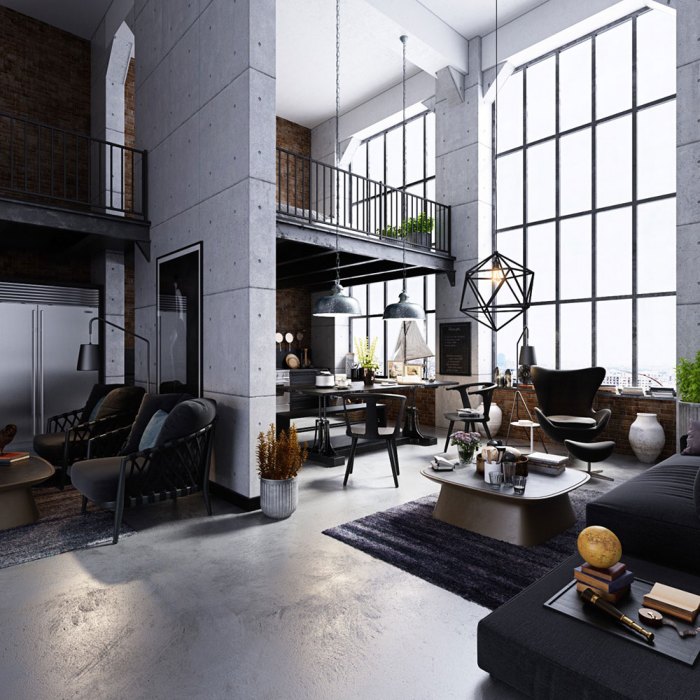
Space planning is a crucial aspect of industrial interior design as it involves optimizing the layout of the space to ensure functionality, efficiency, and aesthetics. Proper space planning can enhance the overall look and feel of an industrial space while also maximizing its usability.
Considerations for Layout in Industrial Spaces
When planning the layout of an industrial space, there are specific considerations that need to be taken into account:
- The flow of work: Ensure that the layout allows for a smooth flow of work processes and operations.
- Zoning: Divide the space into different zones based on their functions, such as production, storage, and office areas.
- Adequate clearance: Leave enough space between equipment, furniture, and walls to ensure safety and ease of movement.
- Natural light: Consider how natural light enters the space and optimize the layout to make the most of it.
Tips for Optimizing Space in Industrial Interiors
Here are some tips to effectively optimize space in an industrial interior:
- Utilize vertical space: Install shelving and storage units that make use of vertical height to maximize storage capacity.
- Multipurpose furniture: Choose furniture pieces that serve multiple functions to save space and increase versatility.
- Clear pathways: Keep walkways clear and unobstructed to facilitate easy movement throughout the space.
Examples of Effective Layout Planning in Industrial Spaces
Effective layout planning in industrial spaces can be exemplified by:
- Creating a centralized work area with easy access to tools and equipment.
- Designing a designated storage area that is easily accessible yet out of the way of main work areas.
- Using modular furniture and fixtures that can be rearranged to accommodate changing needs and workflows.
Lighting Design
Lighting plays a crucial role in industrial interior design, as it not only illuminates the space but also enhances the overall aesthetic and ambiance. Proper lighting can highlight key features, create a sense of warmth, and contribute to the industrial look and feel.
Types of Lighting Fixtures
- Exposed Bulbs: Industrial spaces often feature exposed bulbs, which add a raw and rugged feel to the design.
- Track Lighting: Track lighting allows for adjustable fixtures that can be directed to highlight specific areas or objects.
- Pendant Lights: These hanging fixtures provide focused lighting and can be used to define different zones within the space.
- Wall Sconces: Wall-mounted sconces can add a touch of industrial charm while providing functional lighting.
Enhancing the Industrial Aesthetic
Lighting can enhance the industrial aesthetic by emphasizing the architectural elements of the space, such as exposed brick walls, metal beams, or concrete floors. By strategically placing light fixtures, you can create depth and texture, adding to the overall industrial vibe.
Tips for Achieving the Right Balance of Lighting
- Layered Lighting: Incorporate a mix of ambient, task, and accent lighting to create depth and visual interest.
- Dimmer Switches: Install dimmer switches to adjust the brightness levels and create different moods in the space.
- Utilize Natural Light: Maximize natural light sources by keeping windows unobstructed and using light-filtering materials.
- Statement Fixtures: Choose lighting fixtures that make a statement and complement the industrial style, such as oversized pendants or industrial chandeliers.
Final Conclusion
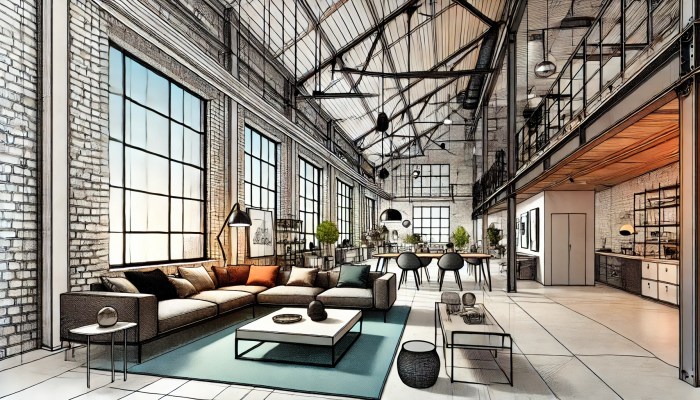
As we wrap up our exploration of industrial interior design, it's evident that the marriage of raw materials and thoughtful design choices results in spaces that are both functional and visually striking.
Questions and Answers
What defines industrial interior design?
Industrial interior design is characterized by the use of raw materials like metal, wood, and concrete, along with exposed architectural elements.
What are some common furniture pieces in industrial interiors?
Commonly used furniture pieces include leather sofas, metal chairs, reclaimed wood tables, and industrial-style lighting fixtures.
How does lighting contribute to the industrial aesthetic?
Lighting fixtures such as exposed bulbs, metal pendants, and industrial sconces play a crucial role in enhancing the industrial look and feel of a space.

